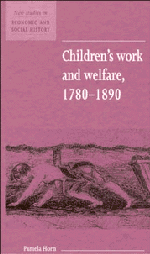2 - The impact of industrialization: 1780–1850s
Published online by Cambridge University Press: 04 August 2010
Summary
‘Traditional’ employments
Despite the increased importance of manufacturing and the associated spread of mass production techniques, in 1851 agriculture and domestic service remained the largest single employers of boys and girls, respectively. In that year over 10 per cent of all males aged 10–14 worked as agricultural labourers or farm servants, and around 6 per cent of all females in the same age group were engaged as general domestic servants and nurse maids. Cottage industries like straw-plaiting and lacemaking were also of major importance for girls, especially in the south Midlands, while a number of boys were occupied in menial services as messengers and errand boys. Shoemaking, too, was still organized on an outwork basis at this time even in areas of major production like Northamptonshire. In 1851 about one in eight of all boys aged 10–14 in that county was engaged in the shoe trade (Stephens, 1987) (see also Appendices 1 and 3).
Many children in these ‘traditional’ occupations throughout the period worked in a domestic situation, under the eye of family and kin or, in the case of servants, under the direction of an employer who exerted close personal control. Work routines could be arduous but they were also flexible, both in content and duration. Unlike in factories, where a strict timetable was imposed and fines were levied for unpunctuality, in these industries the notation of time was ‘task orientated’.
- Type
- Chapter
- Information
- Children's Work and Welfare 1780–1890 , pp. 12 - 34Publisher: Cambridge University PressPrint publication year: 1995



